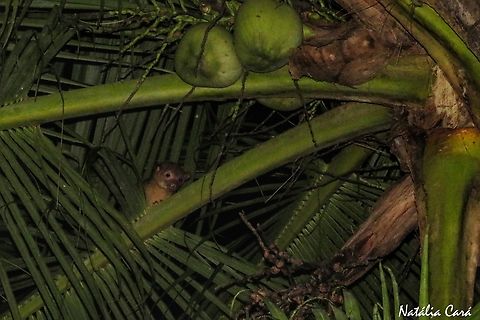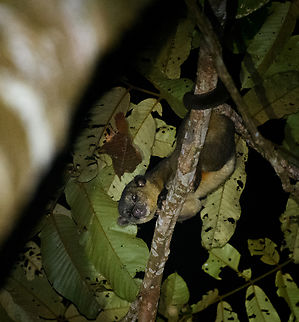
Appearance
The kinkajou has a round head, large eyes, a short, pointed snout, short limbs, and a long prehensile tail. The total head-and-body length is between 82 and 133 cm, and the tail measures 39 to 57 cm. Its mature weight ranges from 1.4 to 4.6 kg. Females are generally smaller than males. The short, rounded ears measure 3.6 to 5.4 cm. The eyes reflect green or bright yellow against light. The long, thick tongue is highly extrudable. The snout is dark brown to black. The claws are sharp and short.The coat color varies throughout the range and at different times of the year. Several shades such as tawny olive, wood brown, and yellowish tawny have been reported for the upper part of the coat and the upper side of the tail, while the underparts and the lower side of the tail have been observed to be buff, tawny, or brownish yellow. Some individuals have a black stripe running along the midline of the back. The color seems to become lighter from the south to the north, though no seasonal trends have been observed. The fur is short, woolly and dense. Hairs are of two types - light yellowish and darker with brown tips. The darker hairs reflect light poorly relative to the lighter ones, often creating an illusion of spots and dark lines on the coat. The tail is covered with thick fur up to the end.
The kinkajou is distinguished from other procyonids by its small, rounded ears, extensible tongue, and prehensile tail. Olingos are similar enough in appearance that many native cultures do not distinguish the two. Compared to olingos, kinkajous are larger, have foreshortened muzzles, and lack anal scent glands. The binturong, a Southeast Asian viverrid, has similar limb proportions and is the only other carnivoran with a prehensile tail. The kinkajou resembles neotropical monkeys in having a prehensile tail and big, forward-facing eyes, but has a different dentition and heavy fur on the soles of the feet.

Naming
The common name "kinkajou" derives from, based on the Algonquian name for the wolverine. It is similar to the Ojibwe word "kwi·nkwaʔa·ke". Its other names in English include honey bear, night ape, and night walker. Throughout its range, several regional names are used; for instance, the Dutch names "nachtaap", "rolbeer", and "rolstaartbeer" are used in Suriname. Many names come from Portuguese, Spanish, and local dialects, such as "jupará", "huasa", "cuchi cuchi", "leoncillo", "marta", "perro de monte", and "yapara".{| style="border: 1px solid #ccc; background-color: white; vertical-align: middle; width: 248px; margin:0.2em 0 0.2em 1em; float:right; clear:right; "
|-
|-
| style="padding: 5px" |
...snipped...
|-
|-
| style="text-align: left; font-size: 88%; border: 0; padding: 0;" | The five clades within "P. flavus"
|}
Eight subspecies have been proposed :
⤷ "P. f. chapadensis" J. A. Allen, 1904: Chapadas of Mato Grosso
⤷ "P. f. chiriquensis" J. A. Allen, 1904: Boquerón, Chiriquí Province
⤷ "P. f. flavus" : Suriname. Synonyms include "Cercoleptes brachyotos", "C. brachyotus", "Mustela potto", and "Viverra caudivolvula"
⤷ "P. f. megalotus" : Santa Marta
⤷ "P. f. meridensis" Thomas, 1902: Mérida
⤷ "P. f. modestus" Thomas, 1902: Montes Balzar, Guayas Province
⤷ "P. f. nocturnus" : São Miguel dos Campos, Alagoas
⤷ "P. f. prehensilis" : Veracruz
A 2016 phylogenetic study based on mitochondrial gene cytochrome b analyzed kinkajou specimens from a variety of locations throughout most of their range. The results showed 27 haplotypes split into five clades corresponding to geographical divisions: Costa Rica, northern Brazil and the Guianas, northern Peru, Ecuador and Panama, interfluves between the Branco River and Rio Negro in the Brazilian Amazon, low-lying Amazonian areas, and eastern Atlantic Forest. Given the diverse clades, the researchers suggested that some of the subspecies might be independent species.

Behavior
Kinkajoin spend most of their lives in trees, to which they are particularly well adapted. Like raccoons, kinkajous' remarkable manipulatory abilities rival those of primates. The kinkajou has a short-haired, fully prehensile tail, which it uses as a "fifth hand" in climbing. It does not use its tail for grasping food. It can rotate its ankles and feet 180°, making it easy for the animal to run backward over tree limbs and climb down trees headfirst. Scent glands near the mouth, on the throat, and on the belly allow kinkajous to mark their territory and their travel routes. Kinkajous sleep in family units and groom one another.While they are usually solitary when foraging, they occasionally forage in large groups, and sometimes associate with olingos. The larger kinkajous are dominant and will drive olingos away when food is scarce. Kinkajous have a much more extensive range than olingos and tend to be more common. However, olingos may have greater agility, perhaps facilitating their sympatry with kinkajous.
As a nocturnal animal, the kinkajou's peak activity is usually between about 7:00 pm and midnight, and again an hour before dawn. During daylight hours, kinkajous sleep in tree hollows or in shaded tangles of leaves, avoiding direct sunlight.
Kinkajous breed throughout the year, giving birth to one or occasionally two small babies after a gestation period of 112 to 118 days.

Habitat
Kinkajous range from east and south of the Sierra Madre in Mexico, throughout Central America to Bolivia east of the Andes and the Atlantic Forest of southeastern Brazil. Their altitudinal range is from sea level to 2500 m. They are found in closed-canopy tropical forests, including lowland rainforest, montane forest, dry forest, gallery forest, and secondary forest. Deforestation is thus a potential threat to the species.
Food
Although the kinkajou is classified in the order Carnivora and has sharp teeth, its omnivorous diet consists mainly of fruit, particularly figs. Some 90% of their diet consists of fruit. To eat softer fruits, they hold it with their forepaws, then scoop out the succulent pulp with their tongue. They may play an important role in seed dispersal. Leaves, flowers, and various herbs make up much of the other 10% of their diet. They sometimes eat insects, particularly ants. They may occasionally eat bird eggs and small vertebrates. Their frugivorous habits are actually convergent with those of spider monkeys.The kinkajou's slender 5-inch extrudable tongue helps the animal to obtain fruit and to lick nectar from flowers, so it sometimes acts as a pollinator. Although captive specimens avidly eat honey, honey in the diet of wild kinkajous is not well reported.

Evolution
A 2007 phylogenetic study showed that kinkajous form a basal lineage sister to the rest of the Procyonidae. They diverged 21.6–24 Mya. Two clades, one leading to "Bassaricyon" plus "Nasua", and one leading to "Bassariscus" plus "Procyon", appeared subsequently and radiated during the Miocene. Kinkajous are thought to have evolved in Central America and invaded South America as part of the Great American Interchange that followed the formation of the Isthmus of Panama. The phylogenetic relationships obtained in the 2007 study are given below; these were supported by similar studies in the following years....snipped...
Uses
Kinkajous are sometimes kept as exotic pets. They are playful, generally quiet, docile, and have little odor, but they can occasionally be aggressive. Kinkajous dislike sudden movements, noise, and being awake during the day. An agitated kinkajou may emit a scream and attack, usually clawing its victim and sometimes biting deeply. In 2011, the Centers for Disease Control and Prevention reported that pet kinkajous in the United States can be carriers of the raccoon roundworm "Baylisascaris procyonis", which is capable of causing severe morbidity and even death in humans if the brain is infected.In El Salvador, Guatemala, and Honduras, pet kinkajous are commonly called "micoleón", meaning "lion monkey". In Peru, pet kinkajous are frequently referred to as "lirón", often described as a "bear-monkey". These names reflect its monkey-like body and obviously carnivoran head.
They typically live about 23 years in captivity, with a maximum recorded lifespan of 41 years.
References:
Some text fragments are auto parsed from Wikipedia.